Second in a series: the first, with the introduction and the years 1801-1806, is here.
1807
Major events: Peninsular War (1807-1814) began as the French invaded Portugal, which offended Napoleon by trading with Great Britain.
Caspar David Friedrich, Cairn in Snow, 1807
Friedrich (1774-1840) was one of the greatest German painters in the Romantic style: he had an amazing ability to impart emotional content via landscape and light.
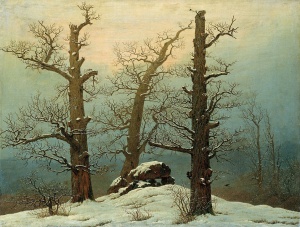
Antonio Canova, Venus Victrix (Pauline Borghese), 1805-1808
Pauline Borghese, nee Bonaparte, was Napoleon’s younger sister. He raised her and all his other family members to noble rank. Canova (1757-1822) was Europe’s leading Neoclassical sculptor.

Beethoven, Symphony No. 5 (“Eroica”), 1808
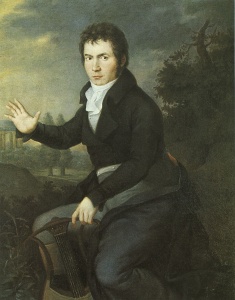
Thomas Moore, “Believe Me, If All Those Endearing Young Charms,” 1808
Background and links to recordings (including Looney Tunes!) are in this post.
William Wordsworth, Poems in Two Volumes, 1807
Including “The World Is Too Much With Us,” Wordsworth’s attack on what he saw as the materialist attitude fostered by the Industrial Revolution. (See also the year 1811.)
The world is too much with us; late and soon,
Getting and spending, we lay waste our powers;
Little we see in Nature that is ours;
We have given our hearts away, a sordid boon! …
Georg Wilhelm Friedrich Hegel, Phenomenology of Spirit, 1807
Per Wikipedia, in his first and most widely discussed work,
Hegel develops his concepts of dialectic (including the master–slave dialectic), absolute idealism, ethical life, and Aufhebung. The book had a profound effect in Western philosophy, and “has been praised and blamed for the development of existentialism, communism, fascism, death of God theology, and historicist nihilism'”(Terry Pinkard, Hegel’s Phenomenology).
1809
Major events: At the Battle of Wagram, Napoleon defeated the Austrians. Men on the field: 300,000. Dead or wounded: more than 50,000.
Jean-Auguste-Dominque Ingres, Pencil portrait of Auguste-Jean-Marie Guenepin, 1809
Ingres (1780-1867), studying in Rome, made money by sketching portraits of wealthy visitors on the Grand Tour.
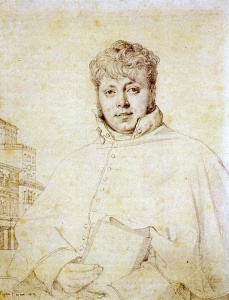
[Washington Irving], A History of New-York from the Beginning of the World to the End of the Dutch Dynasty, by Diedrich Knickerbocker, 1809
Irving was one of the first American authors to earn acclaim on both sides of the Atlantic.
How convenient it would be to many of our great men and great families of doubtful origin, could they have the privilege of the heroes of yore, who, whenever their origin was involved in obscurity, modestly announced themselves descended from a god. …
1811
Major events: Luddite (anti-industrial) riots in Great Britain, 1811-12.
[Jane Austen], Sense and Sensibility, by a Lady, 1811
Elinor agreed with it all, for she did not think he deserved the compliment of rational opposition.
William Thornton, United States Capitol, 1811
Begun in 1791, completed 1811, and partially burned by the British in 1814, during the War of 1812.
1812
In this map, the area outlined in pink was either under Napoleon’s control or allied with him. In 1812, at the height of his empire, Napoleon ruled 50 of the 175 million inhabitants of Europe.

On the grounds that Czar Alexander had failed to abide by the trade embargo with Britain, Napoleon gathered the largest army in history to march on Russia, setting out in summer 1812. After capturing and burning Moscow, the army was decimated on its trip home by hunger, disease, and cold. Of the 685,000 men who had marched towards Moscow, perhaps 10,000 returned home.
This graph by Charles Joseph Minard of the size of Napoleon’s army on his way to Moscow (tan) and on his return (black) is used in Tufte’s The Visual Display of Quantitative Information as a superb example of transforming numbers into graphics.
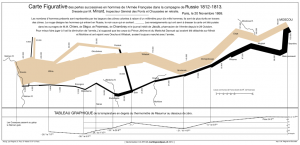
Joseph Mallord William Turner, Snowstorm: Hannibal and His Army Crossing the Alps, 1812
Turner (1775-1851) saw parallels between the Second Punic War (218-201 BC, Hannibal and the Carthaginians vs. Rome) and Napoleon vs. Great Britain. This and many of Turner’s later works were a major influence on the Impressionists (1860s and on).

Francisco Goya, The Third of May 1808, 1812
The painting and its companion, The Second of May 1808, were commissioned by the provisional Spanish government to commemorate Spain’s resistance to Napoleon’s armies during the Peninsular War (1807-1814). In works such as Dona Teresa Sureda, 1805 (see Wednesday’s post), Goya showed the influence of the Neoclassical and Rococo styles. Goya hoped Napoleon would free Spain from the rule of absolute monarchs, but he was embittered by the barbarous actions of the French during the Peninsular War. Few artworks evoke the horrors of war as vividly as this one and Goya’s Disasters of War, a series of prints published from 1810 to 1820.
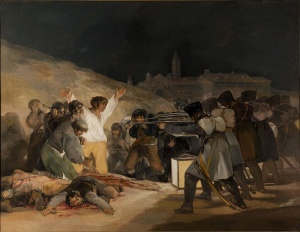
1813
Gioachino Rossini, L’Italiana in Algeri (The Italian Woman in Algiers), 1813
This bel canto opera was composed by twenty-one-year-old Rossini in eighteen days. Napoleon’s expedition to Egypt and the Near East (1798-1801) led to a craze among Europeans for exotic oriental subjects. In this video of the extremely silly septet at the end of Act II, the costumes and setting are vaguely oriental.
Percy Bysshe Shelley, Queen Mab: A Philosophical Poem, 1813
Romantic in the sense of rousing emotion.
How wonderful is Death,
Death and his brother Sleep!
One, pale as yonder waning moon
With lips of lurid blue;
The other, rosy as the morn
When throned on ocean’s wave
It blushes o’er the world:
Yet both so passing wonderful! …
Theodore Gericault, Trumpeters of Napoleon’s Imperial Guard, 1812-1814
Gericault was one of the earliest French painters to work in the Romantic style: I discuss him in Seismic Shifts in Subject and Style, Chapter 4. More on this painting here.
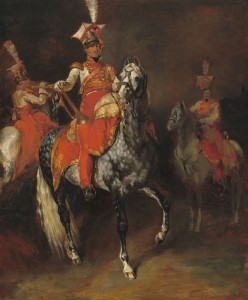
Gericault’s comment on the French Academy illustrates how ideas on the education of artists were changing. (I’m inclined to agree with him when it comes to the education of creative types in large academic settings.)
Supposing that all the young people admitted to our schools were endowed with all the qualities needed to make a painter, is not it dangerous to have them study together for years, copying the same models and treading approximately the same path? After that, how can one hope to have them still keep any originality? Haven’t they in spite of themselves exchanged any particular qualities they may have had, and sunk the individual manner of conceiving nature’s beauties that each one of them possessed in a single, uniform style? The nuances that can survive this sort of confusion are imperceptible; and each year we see with disgust ten or twelve compositions, carried out in about the same way, painted from one end to the other with a disheartening perfection, and showing no trace of originality.
Francisco Goya, The Duke of Wellington, 1812-1814
Wellington defeated Napoleon at Waterloo on June 18, 1815 (see below).

Georg Wilhelm Friedrich Hegel, Science of Logic, 1812–1817
Again per Wikipedia (because I really cannot bear to delve into Hegel myself):
For Hegel, the most important achievement of German idealism, starting with Immanuel Kant and culminating in his own philosophy, was the argument that reality (being) is shaped through and through by thought and is, in a strong sense, identical to thought. Thus ultimately the structures of thought and being, subject and object, are identical. Since for Hegel the underlying structure of all of reality is ultimately rational, logic is not merely about reasoning or argument but rather is also the rational, structural core of all of reality and every dimension of it.
1814
Major events: The French army forced Napoleon to abdicate in April 1814. He was sent to Elba (off the coast of northern Italy) with an honor guard of 800 men. King Louis XVIII assumed the throne of France.
Print showing the bombardment of Fort McHenry, 1814
What did the British do after Napoleon had been sent off to Elba? Turned their attention to those upstart Americans, who had refused to align themselves with Great Britain against the French. When Francis Scott Key watched the British bombardment of Fort McHenry (Baltimore), he was inspired to write the lyrics to what became the “Star-Spangled Banner.” Fort McHenry and the flag are in the middle ground of the image below.
I suspect this print isn’t contemporary – it looks like one of the color lithographs produced by Currier & Ives in the mid-19th century – so take it as a reminder of what the Brits were up to, rather than an example of art in 1814.

[Sir Walter Scott], Waverley, 1814
In his early career, Scott was famous for poetry such as The Lay of the Last Minstrel, 1805. (See Wednesday’s post.) Waverly, which is considered the first historical novel, like, ever, was published anonymously by Scott. He eventually published twenty or so more “Waverley Novels,” including Ivanhoe, the Bride of Lammermoor and Rob Roy. From Waverley:
Now I protest to thee, gentle reader, that I entirely dissent from Francisco de Ubeda in this matter, and hold it the most useful quality of my pen, that it can speedily change from grave to gay, and from description and dialogue to narrative and character. So that, if my quill display no other properties of its mothergoose than her mutability, truly I shall be well pleased; and I conceive that you, my worthy friend, will have no occasion for discontent. …
Lord Byron, The Corsair, 1814
This narrative poem by Lord Byron (1788-1824) sold tens of thousands of copies on its first day of sale. I wonder if today’s writers of bodice-rippers realize how much they owe to Lord Byron?
Sun-burnt his cheek—his forehead high and pale,—
The sable curls in wild profusion veil;
And oft perforce his rising lip reveals
The haughtier thought it curbs, but scarce conceals.
Though smooth his voice, and calm his general mien,
Still seems there something he would not have seen …
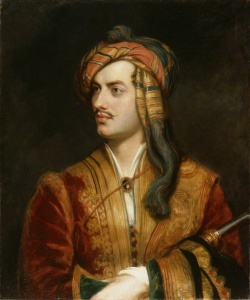
1815
Major events: In March 1815, Napoleon and loyal troops landed at Cannes, then marched on Paris, collecting thousands of soldiers as they went. At Waterloo (just south of Brussels, Belgium), Napoleon and his 120,000 men were defeated by 215,000 British and Prussians under under the Duke of Wellington and Gebhard Leberecht von Blücher, Prince of Wahlstatt. Napoleon surrendered to the British and was exiled to St. Helena (in the southern Atlantic), where he died in 1821.
John Nash redesigns and extends the Royal Pavilion at Brighton, 1815
The Pavilion had been begun in 1787, was revamped by John Nash, and was completed in 1823. It’s the textbook example of exotic, oriental style in architecture.
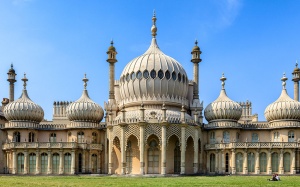
More
- Sometimes I disagree philosophically with Paul Johnson, but in his skill at presenting the broad sweep of history along with telling details, he has few equals among modern historians. His The Birth of the Modern: World Society 1815-1830, which picks up just after the period we’ve been looking at, is a long but very rewarding read.
- My favorite book on Napoleon is J. Christopher Herold’s The Age of Napoleon, which is brilliant at setting the big picture, and paints Napoleon as an enormously important figure – but not admirable. The second page of the main text quotes Napoleon’s letter to his brother a year in 1792, when Napoleon was 23:
Among so many conflicting ideas and so many different perspectives, the honest man is confused and distressed and the skeptic becomes wicked …. Since one must take sides, one might as well choose the side that is victorious, the side which devastates, loots, and burns. Considering the alternative, it is better to eat than to be eaten. (Quoted in Herold, pp. 8-9)
- Want wonderful art delivered weekly to your inbox? Check out my free Sunday Recommendations list and rewards for recurring support: details here.